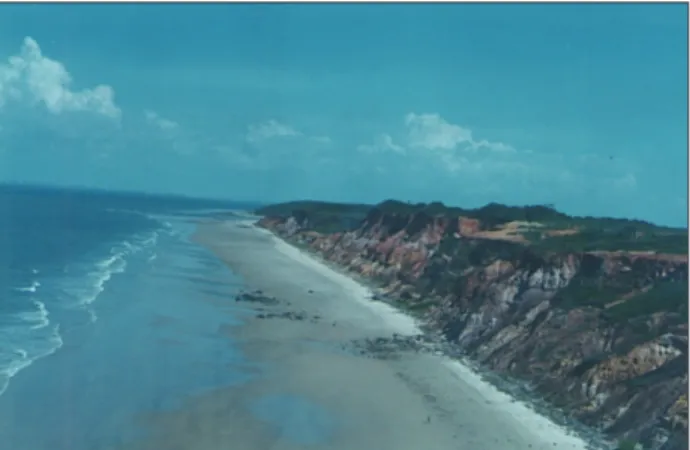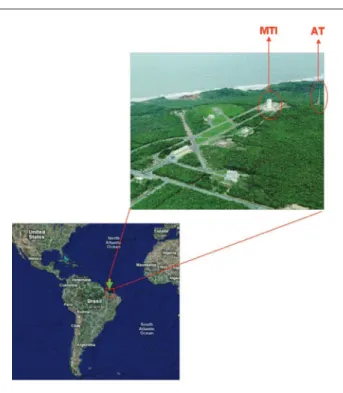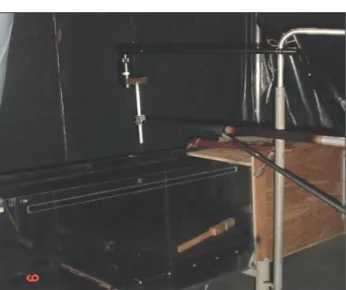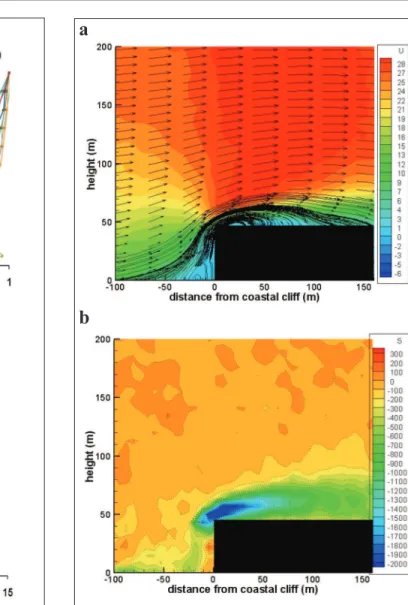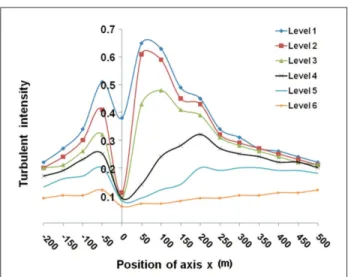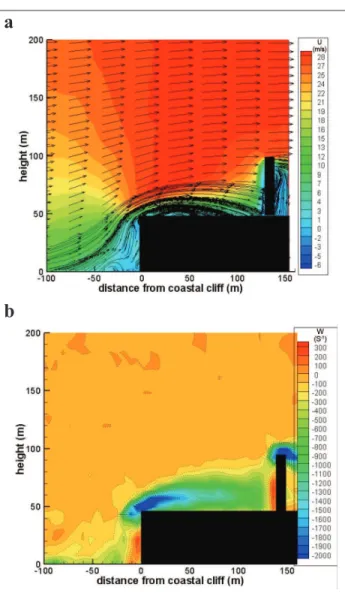Luciana Bassi Marinho Pires*
National Institute for Space Research São José dos Campos – Brazil
lupires@uga.edu
Suelen T. Roballo
National Institute for Space Research São José dos Campos – Brazil
suelen.roballo@cptec.inpe.br
Gilberto Fisch
Institute of Aeronautics and Space São José dos Campos – Brazil
gisch@iae.cta.br
Ana Cristina Avelar
Institute of Aeronautics and Space São José dos Campos – Brazil
anacristina@iae.cta.br
Roberto da Mota Girardi
Technological Institute of Aeronautics São José dos Campos – Brazil
giradi@ita.br
Ralf Gielow
National Institute for Space Research São José dos Campos – Brazil
ralf.gielow@cptec.inpe.br
*author for correspondence
Atmospheric low measurements
using the PIV and HWA techniques
Abstract: Alcântara Space Center (ASC) is the Brazilian gate to the space where rockets of different sizes are launched. At ASC there is a relativetopographical variation, coastal cliff, which modiies the atmospheric
boundary layer characteristics and can cause interference for operations
of rockets. In the present work, a simpliied model (mock-up) was studied
in a wind tunnel. A scale factor of 1:1000 was used and the atmospheric
low was measured using the hot wire anemometer (HWA) and particle
image velocimetry (PIV) techniques. Using of HWA it was possible to
calculate values of average wind speed and luctuations in a set of points of
the section of tests that representing the region of the ASC. Through these measures, other meteorological parameters that represent the atmospheric
low, such as the friction velocity (u*), the roughness length (z0) from the logarithmic proile and the alpha exponent (a) of the power law were
calculated. With the use of the PIV´s technique, the streamlines and the vorticity ields were obtained and it was noticed that the vorticity generated
downwind of the coastal cliff has a strong turbulence (vorticities around 2000 s-1). A rectangular building (simulating the mobile integration tower)
was inserted at the mock-up and the downwind turbulence was similar to
the one generated by the coastal cliff.
Keywords: Alcantara Space Center, Wind proile, Turbulent intensity, Vorticity, Stream lines.
INTRODUCTION
The knowledge of the atmospheric low at the Space Launch
Centers (like Kennedy Space Center – the US Space Port, and French Guiana Space Center – French/Europe Port) is very
important due to its inluence on the research & development (R&D) of the rockets. The trajectory, guidance and control of the rockets are inluenced by the wind proile, especially
near the surface, as well as the wind loads at surface and
upper air. Up to a height of 1000 m, 88% of the trajectory
corrections are due to the winds, while there are only 3% of
wind corrections above 5000 m (Fisch, 1999).
Alcântara Space Center (ASC) is the Brazilian gate to the space where rockets are launched and it is located at the north coast of the state of Maranhão, close to the Equator. This region has a very special topography, with a smooth surface (ocean) close to a rough surface (continent). At
the border there is a step (coastal cliff) with a 50 m of
height, as shown in Fig. 1. The launch pad of the rockets
is located close to this border (150 m) and it suffers an intense turbulence due to the modiication of the wind proile blowing from the ocean to the continent.
Although the wind data are usually made at meteorological
stations, vertical proile measurements (like an
anemometric tower or mast) give a detail of the winds in certain localizations. In general, the characteristics of the
wind are divided in four groups: the vertical proiles of wind characteristics, the speed, the turbulence intensity and the spectral turbulence (Liu, 1990). Johnson (2008),
for example, made a complete compilation of the main
climatic elements that inluence rocket launchings in
the United States, giving a special attention to the winds
(surface and upper air). Kwon, Lee and Sung (2003) made
experiment studies using a wind tunnel to analyze the
Received: 08/06/10 Accepted: 26/07/10
atmospheric conditions of the island of Oenaro-Do, where the space center of South Korea is being constructed.
The wind tunnels are used by micrometeorology science due to its advantage of controlling the low, which
optimizes the data collection, the sensitivity analysis and
the scientiic insights. In the recent applications found in the literature using wind tunnels, it can be cited simulations with the coupling between forest and atmosphere (Novak et al., 2000) that analyzed the turbulent structure of the atmosphere within and above canopy, pollutant dispersion ields immersed in obstacles (Mavroidis, Grifiths and Hall, 2003), besides simulation of the air low for
complex topography (Cao and Tamura, 2006). Recently,
Abu-Mulawech (2005) carried out a detailed analysis of the inluence of the forward facing-step problem related
to different heights for a mixed convection (natural and forced).
The objective of this work was to study the atmospheric low in the region of ASC through experiments in
wind tunnel. The analysis was performed through the
wind proiles, ields of vorticity, streamlines, turbulent intensities and luctuation of the wind speed in each point of the interest region, using data obtained with the hot wire
anemometry (HWA) and the particle image velocimetry
(PIV) techniques. The results were obtained from the MSc dissertation of Roballo (2007) and from the PhD thesis of Pires (2009).
WIND PROFILES AT NEAR-NEUTRAL CONDITIONS
Neutral stability conditions are scarce in the real
atmosphere (Arya, 2001). For strong winds with mean
hourly wind speed higher than 10.0 m/s, the low is suficient turbulent to mix vertically the atmosphere and suppress the thermal (buoyancy) effects (Loredo-Souza, Schettini and Paluch, 2004). At the near neutral conditions, the atmospheric turbulence is purely originated from
the wind shear (mechanically driven) and depends on the friction of the surface and the vertical wind shear.
This work assumed a neutral stability at ASC due to the
strong winds, independently of the hour of day (daily
cycle) for both wet and dry conditions (seasonal cycle). A
complementary study using a different data set made with sonic anemometer (Magnago, Fisch and Moraes, 2010)
conirmed this hypothesis.
There are some theoretical and experimental laws to
represent the wind proile, like logarithmic and power
law, respectively (Arya, 2001). The vertical variation of the mean wind speed (U) up to approximately 100-150 m
above a roughness surface can be represented as (Eq. 1):
U z u
k z z
( )=⎛ * ln
⎝ ⎜ ⎞ ⎠ ⎟ ⎛ ⎝ ⎜ ⎞ ⎠ ⎟ 0 (1) where:
u* is the friction velocity (m/s);
k is the Von Karman´s constant and assumed to be 0.40;
z0 is the roughness aerodynamic length (m).
An observational study (Roballo and Fisch, 2008), using a wind tower (70 m height) at ASC, has obtained values of roughness aerodynamic length between the classes 0.0-0.1 m. The friction velocity was in the interval between 0.3 and 0.4 m/s for the wet period and between 0.4-0.5 m/s for the dry period. These results will be compared with the
measurements made at the wind tunnel.
The power or wall law is deined by the Eq. 2:
U z U z z z r n r n ( ) ( )= ⎛ ⎝ ⎜ ⎞ ⎠ ⎟ a (2)
where U(z) and U(zr) are mean wind speed equivalent to a height z and a reference height zr, respectively.
The value of zr is assumed to be 10 m as it is the value suggested by the World Organization of Meteorology
(WMO) to represent the surface wind. The exponent alpha
for the observational study by Roballo and Fisch (2008) was found to be in the range of 0.20-0.25 (dimensionless).
Usually statistical means and luctuations are used to represent the turbulent structure, but in this work the concept of the turbulence intensity was used, deined as the ratio between the standard deviation (s) and the mean wind speed (U) (Eq. 3):
I U
=s (3)
LOCALIZATION OF THE REGION OF THE STUDY
The ASC is situated at the village of Alcântara at the north coast of the state of Maranhão, at geographic coordinates
Integration (MTI), where the rockets are launched, and the
anemometric tower (AT) whose data has been used and
compared with the simulations.
The climate of Alcântara shows a seasonal rainfall regime divided into two different periods: a wet period from
January to June and a dry period from July to December. During the wet period, the precipitation is typically
around 200 mm per month, while at the dry season the rainfall is lower than 20 mm per month. The winds are
very distinct between both seasons: during the wet season
(March is a characteristic month), the winds are weaker and associated with the trade winds. The wind direction is
from east up to 5000 m, with wind speed around 7.0 and 8.0 m/s between the levels of 1000 and 3000 m. For the dry season (September), there is a superposition between the trade winds and the sea breeze, producing stronger
winds. The direction is from east up to 8000 m height,
reaching maximum velocities between 10.0 and 15.0 m/s at 2000 m. The sea breeze is more intense during the dry period because the thermal difference between oceanic
and continental surface. The air temperature and humidity do not present seasonality and their values are very typical
of the tropics (Fisch, 1999).
METODOLOGY
The experiments were carried out at the wind tunnel
installed at the Professor Kwein Lien Feng Laboratory in
the Technological Institute of Aeronautics (ITA, acronym
in Portuguese), constructed for the Plint & Partners LDD Whokingham Bershire England (Serial n º TE 44/5065).
This wind tunnel is an opened conventional model,
subsonic (Fig. 3a). The test sections have the dimensions of 0.46 m x 0.46 m with length of 1.20 m. For the irst tests a canal apparatus made by wood was used (with an open lid and internal width of 0.41 m) to allow the fully development of the boundary layer proile (Fig. 3b). The air low is produced by electric fans with the power of
30 hp. The wind generated in the tunnel is of 33 m/s, approximately equivalent to 120 km/h. The scale in this tunnel is 1:1000.
Figure 2: Geographic localization of ASC, MTI and AT.
Figure 3: The wind tunnel (a) and an overview of the wind tunnel with the woody extension (b).
a
b
Measurements with hot wire anemometer (HWA)
The HWA used was a 5 μm tungsten probe constant
temperature anemometer (CTA) from Dantec (AN-1005
HWA System) with a sample rate of 1 kHz. There was no spectral information collected during the tests. The uncertainties of the measurements were computed as
At the mock-up developed to represent the atmospheric
low in Alcântara, it was necessary to install few spires in order to simulate the atmospheric wind proile. These spires
consist of triangular steel plates, which were positioned in
the entrance of measurements chamber and combined with the roughness (a carpet was used) to produce the boundary layer proile for the wind low (Santa Catarina, 1999).
Figure 4 represents a lateral view of the mounted mock-up. It was also possible to observe an apparatus (to represent the coastal cliff) that was inserted after the adjustment of the boundary layer inside the wind tunnel. Some measurements
were made without the “apparatus step” that simulates the
coastal cliff in order to adjust the exponent alpha of the power law (Eq. 2) to a value of 0.15. This value is typical of smooth surface, like the ocean (Blesmann, 1973).
The measured heights were controlled by a positioning system which is able to move in three directions. The
heights of measurements were: 0.006, 0.01, 0.02, 0.03,
0.04, 0.07, 0.09, 0.11, 0.13, 0.15, 0.17, 0.19 and 0.21 m, and the irst six correspond to the levels of AT (Roballo and Fisch, 2008). The maximum speed obtained was close to 22.0 m/s corresponding to a Reynolds number (Re) in
the order of 104. The height length considered was 50 m (equivalent to the height of the cliff).
Figure 6 represents a schematic design of the measurements. A coordinate system (x,y) was used as a reference system, where the negative x values correspond to the ocean (upwind of the coastal cliff) and the positive x values correspond to the continent (downwind).
Figure 4: Lateral view of the mounted mock-up.
After the adjustment of the boundary layer proile, a step
apparatus was inserted in order to represent the coastal
cliff (Fig. 5). This coastal cliff was positioned at a distance of 1.99 m. In order to fully investigate the role of the coastal cliff in creating turbulence, besides this experiment (Experiment 1), three others experiments (2, 3 and 4) were
designed and simulated at the wind tunnel:
Experiment 1 Experiment 2
Experiment 3 Experiment 4 Figure 5: Schematic representation of the experimented
models investigated in the wind tunnel.
a) apparatus smooth step (90°) – Experiment 1;
b) apparatus smooth step (70°) – Experiment 2;
c) apparatus smooth step (70°) with local vegetation
(simulated by woody cubes of 0.003 m) – Experiment 3;
d) apparatus perpendicular step (90°) with local vegetation – Experiment 4.
Figure 6: Superior view of the experimental design with the coordinates x (longitudinal) and y (lateral).
Measurements with particle image velocimetry
For the second tests, the devices used for the formation of a
typical atmospheric proile were: insertion of spires, a screen (0.005 x 0.005 m) and a carpet for ine adjustment. The
screen was introduced in order to reduce the length necessary
to form the atmospheric proile (AP) to be at the optical
access to particle image velocimetry (PIV). Techniques of generation of atmospheric proile in short test section wind tunnelwere described by Pires (2009). It was formed at 1.42 m from the screen and with a height approach of 0.20 m. Figure 7 shows a schema of the experimental apparatus used.
Figure 7: Experimental apparatus used for the experiments of the AP and of the ASC region.
MTI has the same effect in the low as a building. A study about building ampliication factors (BAF) for sources near buildings was carried out by Thompson (1993) in a wind tunnel. BAF are deined as the ratio of the maximum ground-level (or building-surface) concentration observed to the maximum observed for the same source in the absence of the building. This study described a point-source release of no buoyant material at various positions near isolated rectangular buildings located on lat terrain,
where low and high releases were analysed, and concluded
that in low releases may be entrained into the building’s highly turbulent low region and result in high pollutant concentrations on the building surface where building
air intakes are located and high releases may result in increased concentrations at ground level downwind of the
building as a result of the building’s inluence on the mean low ield.
The free wind speed (u∞) ranged from 27 to 30 m/s corresponding to a Re of the order 104 based on the height
of the coastal cliff of 40 m. This was the maximum Re values obtained for this wind tunnel. In the atmosphere, the Re is higher basically of the order of 106.
Air low velocity ields were obtained using a two dimensional PIV system. The test section low was seeded with smoke particles, approximately 0.005 m in diameter,
using a Rosco Fog generator. An Nd-YAG, 200 mJ/pulse
laser of 532 nm wavelength, was employed to illuminate the low ield. A vertical laser sheet was created using an
articulated arm (Fig. 8) and a set of lenses with thickness
adjustment of the laser. A 60 mm m diameter Nikkor lens
(Nikon®) were itted to 12-bits high-resolution digital
camera (HiSense 4M, Dantec Dynamics) that uses a CCD with 2048 x2048 pixels and a 7.4 μm pixel pitch to record
the low ield. The instantaneous images were processed
using the adaptive-correlation option of the commercial
software Flow Manager 4.50.17, developed by Dantec Dynamics. A 32 x 32 pixels interrogation window with
50% overlap and moving average validation was used.
The camera and the source of the laser were located in a three axes system positioning.
As shown in Fig. 9, for the accomplishment of the measurements with PIV, the mock-up was painted in lat black color in order to minimize the relections of the laser
that intervene with the measurements. The region of the experimental apparatus was isolated to prevent accidents
caused by laser relections and to minimize the inluence
of the surrounding light in the measurements.
RESULTS AND DISCUSSION
Figures 10a and b represent, respectively, the proiles of the wind speed and the luctuation of the wind along
the central line. The heights had been normalized by
the height of reference d = 0.21 m, as well as the values
of wind speed had been normalized by the wind speed at this height. It is possible to observe that upstream of the step (x < 0, in Fig. 6) the mean of wind proiles had presented characteristics of uniform low, with low values of luctuations. In the region of the step (x = 0), it was observed that mean wind low pattern was disturbed, with the formation of regions with high values of luctuations. This was mainly observed close to the
surface (up to the normalized height of 0.2) and for a longitudinal distance corresponding a height of 200 m from the edge.
Figure 11 shows mean low ield of vorticity and velocity obtained from the PIV measurements. The mean vorticity is a measure of the turbulence was computed by (Eq. 4):
Figure 8: Section of test and articulated arm.
Ωz
V x
U y
=∂
∂ − ∂
∂ (4)
The negative values is for clockwise rotation and positive
values for anti-clockwise. It can be observed a separation
region on the coastal cliff corner with the formation of a
recirculations bubble. For this situation, the Re was 7.5 x 104.
The increase of the luctuation cited above is related to the recirculation region caused by the coastal cliff (Fig. 11a) and the highest luctuations of the turbulence can be seen through the vorticity ield (Fig. 11b), where it is possible to observe
negative vorticities values (-2000 s-1), because reverse low.
The turbulent intensity (Eq. 3) was computed for the levels of the anemometric tower (6, 10, 16.3, 28.5, 43 and 70 m) and is shown in Fig. 12. It is possible to observe that I is very high
close to the surface, especially close to edge, where values
of 0.7 at level 1 were reached. There is also a signiicant
decrease of I with height, and at the level 6 (equivalent to 70
m height) the turbulent intensity is around 0.1 for all positions
along the central line. The distance of 300 m (upstream of coastal cliff edge) was estimated as the distance where the
turbulence originated by the edge disappears.
The values of the exponent alpha from the power law
were obtained from the linearization of the Eq. 2, which resulted in Eq. 5:
log (5)
These values were also obtained by plotting log (U(z)/ U(zr)) against log (z/zr). The alpha was computed from
the adjusted linear regression (angular coeficient). Figure
13 shows an example of the procedure.
a
b
Figure 10: Average velocity proile (a) and luctuating velocity proiles (b) along the central line obtained with the HWA.
a
b
Figure 12: Turbulence Intensity distribution along the central lane (position y = 0).
Table 1: The alpha values for the central lane
Position (m) ALPHA
Experiment 1 Experiment 2 Experiment 3 Experiment 4
x = -200 0.21 0.20 0.21 0.22
x = -150 0.24 0.24 0.22 0.22
x = -100 0.31 0.34 0.36 0.28
x = -50 0.40 0.41 0.41 0.41
x = 200 - 0.46 0.34 0.35
x = 250 0.24 0.39 0.27 0.28
x = 300 0.24 0.30 0.24 0.28
anymore. The values of alpha at x = 200 m are higher than
the values founded by Roballo and Fisch (2008), although similar values are obtained at a distance of 300 m.
The meteorological parameters (u* and z0) of the logarithmic law (Eq. 1) were also computed and compared
with the observations of Roballo and Fisch (2008). The distributions for u* and z0 at the central line (position y
= 0) are shown in Figs. 14 and 15, respectively. At the
Figure 13: Example of the determination of alpha by Eq. 5.
From Table 1, which summarizes the results from all experiments, it is possible to notice that the power law cannot be applied close to the border due to the region of
re-circulation. Upstream the coastal cliff (at x = -200 m), all values of alpha were very close. This is an indication
that the coastal cliff will not inluence this position
Figure 14: Distribution of u*.
position of the edge (x = 0), there is an abrupt decrease
of the values of u* and z0 for Experiment 1. For the others experiments, this variation is not so intense due to the higher degree of smoothness from the topography (Experiments 2 and 3) or the inclusion of the vegetation
(Experiment 4). The results from the inclusion of the
vegetation indicates an increase of the mixture of the vertical transports. The values of z0 at the position 200
m showed very high numbers and this situation can be
associated with lower Re of 104 (instead of the typical value of 107 for real atmosphere). This situation (Fig.
12) permits the re-circulation zone to be longer (at the
wind tunnel measurements) than it is in reality. At the position x = 300 m from the edge the roughness presents
a value of 0.1 m, similar to the observed values obtained by Roballo and Fisch (2008).
Table 2 presents the results for u* for all the experiments
and the observations. The dimensionless value
corresponds the ratio of u* (for experiment values at
the wind tunnel as for observation values) with the
characteristic velocity in the wind tunnel. This procedure was used with the purpose of to allowing a comparison
between observational and the experimental results. The Experiment 2 presented the best agreement between measurements and observations.
Figure 16 shows results of PIV measurements with the
presence of MTI. It is possible to observe changes in the low pattern when reaching the MTI, illustrated by the stream lines (Fig. 16a). After the MTI the low seems to
form a von Karman street vortex.
The vorticity generated at the coastal cliff (Fig. 16b) has the
same intensity of those generated on the MTI (-2000 s-1)
and these are the zones of higher turbulence.
It is possible to verify that upstream the MTI, the vorticity of low is of approximately -900 s-1 and that downstream
a
b
Figure 16: (a) stream lines and (b) vorticity with the MTI.
Table 2: Comparisons of the values of u* for all experiments Comparison of u* experiment versus
observation u* (m/s)
Characteristic velocity (m/s)
Dimensionless
value Re
Wind Tunnel Experiment 1 1.80 22 0.08 6.52 x 104
Experiment 2 1.20 22 0.05 6.52 x 104
Experiment 3 1.47 22 0.06 6.52 x 104
Experiment4 1.53 22 0.07 6.52 x 104
Observations Wet period 0.3-0.4 8 0.04 2.37 x 107
Dry period 0.4-0.5 10 0.04 2.92 x 107
Obs.: The magnitude order of the Reynolds number (Re) is lower in the wind tunnel due to reduction of scale of the height of the coastal cliff, which in this case is 0.05 m.
CONCLUSIONS
The HWA technique was proved to be very appropriate for mean wind proiles and luctuations measurements at the ASC simulation in wind tunnel. Due to the limitation in the wind tunnel’s velocity, high Re typical
of the atmosphere (order of 105 or 106) was not obtained. However, this study developed an initial procedure to
understand the atmospheric low at ASC using wind tunnel, presenting important behaviors such as the displacement, the formation of circulation bubble and the reattachment of the low on the tunnel surface.
With the PIV technique it was possible to get a general view of the low based on streamlines and vorticity. A modiication of the low when reaching the step (coastal cliff) was veriied, as well as the formation of the recirculation region. During the second tests, measurements had been conducted with the simulation
of the MTI existing in the ASC, where the rockets are
positioned for the launching. An alteration of the low was observed by the streamlines in the place, forming a
von Karman street vortex. The vorticity in the localization of the MTI resulted in the same one that was occurred
during the passage of the low by the coastal cliff.
Comparing the results of velocity low map and mean vorticity obtained with PIV and turbulence intensity values obtained with HWA, it was observed that the highest values of turbulence intensity occurs in the identiied low separation regions and that the lowest turbulence intensity was observed in the free stream
regions, as expected.
REFERENCES
Abu-Mulawech, H.I., 2005, “Turbulent mixed convection low over a forward-facing step – the effects of step heights”. International Journal of Thermal Sciences, Vol. 44, No 2, pp. 155-162. doi: 10.1016/j.ijthermalsci.2004.08.001.
Arya, S.P., 2001, “Introduction to micrometeorology”, 2nd edition, Elsevier ISE, Maryland Heights, MO, USA,
420 p.
Blessmann, J., 1973, “Simulação da estrutura do vento natural em um túnel de vento aerodinâmico”, Ph.D. Thesis, Instituto de Aeronáutica e Espaço, São José dos
Campos, SP, Brazil.
Cao, S. and Tamura, T., 2006, “Experimental study on
roughness effects on turbulent boundary layer low over a
two-dimensional steep hill”. Journal of Wind Engineering
and Industrial Aerodynamics, Vol. 94, No 1, pp. 1-19. doi: 10.1016/j.jweia.2005.10.001.
Fisch, G., 1999, “Características do peril vertical do vento no Centro de Lançamento de Foguetes de Alcântara (CLA)”. Revista Brasileira de Meteorologia, Vol. 14, No
1, pp. 11-21.
Jonhson, D.L., 2008, “Terrestrial environment (climatic)
criteria guidelines for use in aerospace vehicle
development. (NASA/TM-2008-215633)”, NASA Marshall Space Flight Center, Huntsville, AL, 472 p.
Kwon, K.J., Lee, J.Y., Sung, B., 2003, “PIV measurements on the boundary Layer Flow around Naro Space Center”, In: Proceedings of the 5th International Symposium on Particle Image Velocimetry, Busan, Korea, pp. 22-24.
Liu, H., 1990, “Wind engineering: a handbook for
structural engineers”, Prentice Hall, Upper Saddle River,
NJ, USA, 224 p.
Loredo-Souza, A.M, Schettini, E.B.C, Paluch, M.J., 2004, “Simulação da camada limite atmosférica em túnel de
vento”, In: Möler, S.M, Silvestrini, J., Anais da IV Escola
de Primavera Transição e Turbulência, Vol. 4, Porto
Alegre, Brazil, pp. 137-163.
Magnago, R.O, Fisch, G., Moraes, O.L.L., 2010, “Análise Espectral do Vento no Centro de Lançamento de Alcântara (CLA)”. Revista Brasileira de Meteorologia, Vol. 25, No
2, in press.
Mavroidis, I., Grifiths, R.F., Hall, D.J., 2003, “Field and
wind tunnel investigations of plume dispersion around
single surface obstacles”. Atmospheric Environment, Vol. 37, No 21, pp. 2903-2918. doi: 10.1016/S1352-2310(03)00300-5.
Novak, M.D., et al., 2000. “Wind tunnel and ield measurements of turbulent low in forests. Part I: Uniformly thinned stands”. Boundary Layer Meteorology, Vol. 95, No 3, pp. 457-495.
Pires, L.B.M., 2009, “Estudo da Camada Limite Interna desenvolvida em falésias com aplicação para o Centro de Lançamento de Alcântara”, Ph.D. Thesis, Instituto
Nacional de Pesquisas Espaciais, São José dos Campos,
SP, Brazil, 165p, Available at: <http://urlib.net/sid.inpe.br/ mtc-m18@80/2009/06.22.18.27>.
Roballo, S.T., 2007, “Estudo do escoamento atmosférico no Centro de Lançamento de Alcântara (CLA) através
de medidas de torre anemométrica e em túnel de vento.
(INPE-14824-TDI/1264)”, Master of Science dissertation,
Instituto Nacional de Pesquisas Espaciais, São José dos
Roballo, S.T., Fisch, G., 2008, “Escoamento atmosférico no Centro de Lançamento de Alcântara (CLA): parte I - aspectos observacionais”. Revista Brasileira de Meteorologia, Vol. 23, No 4, pp. 510-519.
Santa Catarina, M.F., 1999, “Avaliação do escoamento no Centro de Lançamento de Foguetes de Alcântara:
estudo em túnel de vento, Relatório Final de Atividades
de Iniciação Cientifica”. Instituto Tecnológico de
Aeronáutica, São José dos Campos, SP, Brazil, 72 p.
